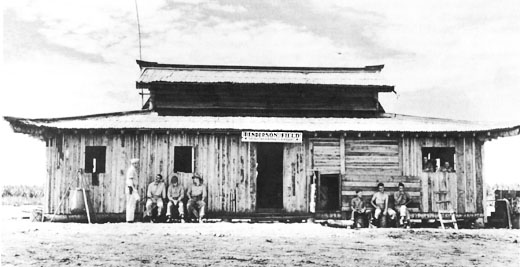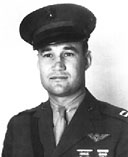
The Pagoda at Henderson Field, served as headquarters for Cactus Air Force throughout the first months of air operations on Guadalcanal. From this building, Allied planes were sent against Japanese troops on other islands of the Solomons.
Determined to knock out Henderson Field and protect their soldiers landing in strength west of Koli Point, the enemy commanders sent the battleships Kongo and Haruna into Ironbottom Sound to bombard the Marine positions. The usual Japanese flare planes heralded the bombardment, 80 minutes of sheer hell which had 14-inch shells exploding with such effect that the accompanying cruiser fire was scarcely noticed. No one was safe; no place was safe. No dugout had been built to withstand 14-inch shells. One witness, a seasoned veteran demonstrably cool under enemy fire, opined that there was nothing worse in war than helplessly being on the receiving end of naval gunfire. He remembered "huge trees being cut apart and flying about like toothpicks." And he was on the front lines, not the prime enemy target. The airfield and its environs were a shambles when dawn broke. The naval shelling, together with the night's artillery fire and bombing, had left Cactus Air Force's commander, General Geiger, with a handful of aircraft still flyable, and airfield thickly cratered by shells and bombs, and a death toll of 41. Still, from Henderson or Fighter One, which now became the main airstrip, the Cactus Flyers had to attack, for the morning also revealed a shore and sea full of inviting targets.
The expected enemy convoy had gotten through and Japanese transports and landing craft were everywhere near Tassafaronga. At sea the escorting cruisers and destroyers provided a formidable antiaircraft screen. Every American plane that could fly did. General Geiger's aide, Major Jack Cram, took off in the general's PBY, hastily rigged to carry two torpedoes, and put one of them into the side of an enemy transport as it was unloading. He landed the lumbering flying boat with enemy aircraft hot on his tail. A new squadron of F4Fs, VMF-212, commanded by Major Harold W. Bauer, flew in during the day's action, landed, refueled, and took off to join the fighting. An hour later, Bauer landed again, this time with four enemy bombers to his credit. Bauer, who added to his score of Japanese aircraft kills in later air battles, was subsequently lost in action. He was awarded the Medal of Honor, as were four other Marine pilots of the early Cactus Air Force: Captain Jefferson J. DeBlank (VMF-112); Captain Joseph J. Foss (VMF-121); Major Robert E. Galer (VMF-224); and Major John L. Smith (VMF-223).

Maj Harold W. Bauer, VMF-212 commander

Capt Jefferson J. DeBlanc

Maj Robert E. Galer